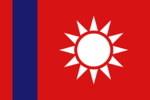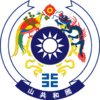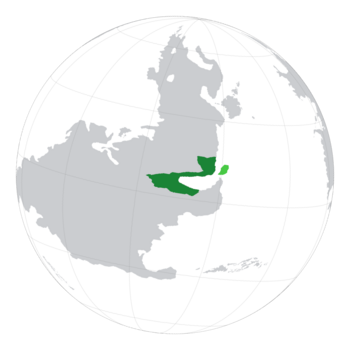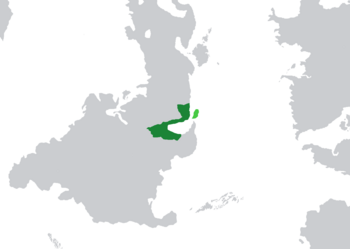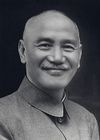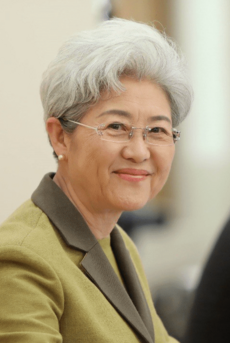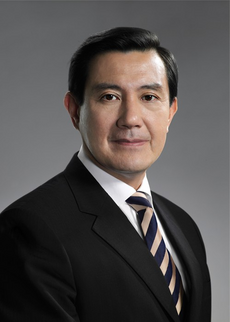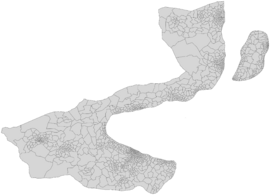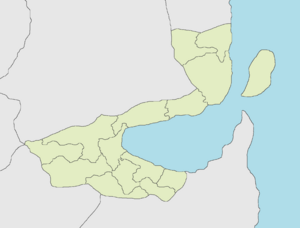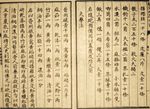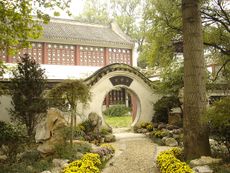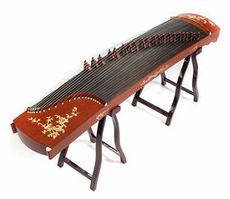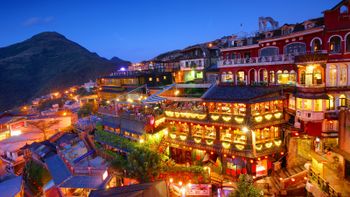Monsilva
Monsilvan Republic | |
|---|---|
Motto: 我們以實力統治,而非脅迫 "We rule by strength, not coercion" | |
Location of Monsilva (dark green) in Terraconserva (dark and light grey) | |
| Capital and largest city | Amking |
| Official languages | Monsilvan |
| Ethnic groups (2018) |
|
| Religion (2018) | |
| Demonym(s) | Monsilvan |
| Government | Federal parliamentary republic |
| Chiu Zan | |
| Xu Yan | |
| Legislature | Parliament |
| Senate | |
| Legislative Assembly | |
| Formation | |
• Establishment of the Xia Dynasty | c. 820 BCE |
| October 1201 | |
• Exit from the Empire of Baltanla[1] | 1 January 1730 |
| 26 August 1830 | |
| 25 December 1978 | |
| Population | |
• 2022 census | |
| GDP (nominal) | 2022 estimate |
• Total | |
• Per capita | |
| Gini (2018) | medium |
| HDI (2019) | very high |
| Currency | Monsilvan Yupian 玉片 (M¥ or 玉) (MSY) |
| Time zone | AMT+12 (Monsilvan Standard Time, MST) |
| Date format | YYYY-MM-DD |
| Driving side | left |
| Calling code | +405 |
| Internet TLD | .ms |
Monsilva, officially the Monsilvan Republic, is a coastal country in Ostlandet, with Baltanla to the west, the Kivu Ocean to the east, Fujikuni and Akvarelusus to the north and Zloveshchiy to the south. The territory of Monsilva is split up into 14 states. The nation consists of mountain ranges dominating the western side of the country, whereas plains and coastal areas dominate the east, where its highly urbanised population is concentrated. The capital, Amking, forms along the southern part of the Monsilvan coast. Other major cities include Luhai, Maojie, Menchi, and Shangrao. Monsilva has just over 50 million inhabitants.
The lands of Monsilva have been settled for at least 20,000 years. Ancestors of Monsilvan ethnic peoples settled there around 6,000 years ago. In the 13th century, the multiple kingdoms with similar ethnic backgrounds united together into the first united Monsilvan dynasty. In 1500, the Zhou dynasty was formally annexed by the Empire of Baltanla and remained a part of the empire until 1730 after a referedndum. Two years later, the Kingdom of Great Shan was formally declared in the 1732 and became a well-known name among merchants and traders from many nations for Monsilva's many spice and plant-based exports. In the 1820s, the Kingdom of Great Shan was overthrown in a civil war and the first Kingdom of Monsilva was declared in its place. The kingdom however, suffered from much corruption and although it was a constitutional monarchy, its democratic system was inefficient and accurately represented only a very small minority of the population.
After struggling through political and economic turmoil, riots and protests began to erupt in different parts of Monsilva. In February 1978 the protests began to be nationwide and by October the riots lead to the entire Monsilvan government resigning and the Emperor of Monsilva abdicating, ending 2800 years of monarchy in Monsilva. On 25 December 1978, the Monsilvan Republic was established by Xu Zhou-da, the president of the Monsilvan Revolution Army, the main orchestrator of the riots.
During the period from 1978 to present, Monsilva underwent many changes politically, economically, militarily, technologically and culturally. Monsilva experienced what is locally known as the "Monsilvan Miracle" during the period from 1978 to 1992. The 'miracle' included; the democratic development of Monsilva from a troubled constitutional monarchy into a parliamentary democracy; almost quadrupling its economy and lowering wealth inequality by 500% and massively improving its civil rights. Since 1978, Monsilva has been known as the Monsilvan Republic and has developed its foreign relations and opened its borders to more tourists from across Ostlandet and Terraconserva.
The Monsilvan Republic is a member of the Ostlandet Union and of the TCN, but claims to continue its government policy of 'peace over conflict'. Monsilva has no long-standing negative relations with any country and prefers to take a pragmatic stance on international politics. Monsilva does have a military and has closer relations with certain nations over others. For example, Monsilva joined the Ostlandet Union, established open borders with the neighbouring country of Fujikuni and massively increased economic cooperation with another neighbouring country, Baltanla. As of November 2022, Monsilva's export-oriented economy is Terraconserva's 10th largest by nominal gross domestic product (GDP); it has a very high human development index; and has a score of 8.68 in the Global Democracy Index, defining it as a full democracy. Monsilva also performs highly in education, healthcare and life-expectancy.
Contents
Etymology
Before the 1830 Treaty of Luhai, Monsilva was not in common use and was not the official name of the nation. Instead was referred to as the Kingdom of Great Shan. The name 'Shan' comes from the Monsilvan shān meaning 'mountain'. The first pictograms of the Shān character appeared as a crown, so this, alongside the word 'Great' were used to refer to the importance of the Monsilvan monarchy.
After the Monsilvan Civil War, the Kingdom of Great Shan became the Kingdom of Monsilva. The name Monsilva is the latinized version of the Monsilvan name for the nation, 山國 (Shānguó), where 山 (Shān) means mountain and 國 (guó) means country. So the literal translation would be Mountain Country. However, when presenting the name of Monsilva to foreign merchants and diplomats from nations which spoke languages that were far to different to Monsilvan, officials of the Monsilvan government at the time tried to give them a name for the nation in a language which they believed the foreign visitors spoke. Unfortunately, due to the Kingdom of Great Shan's minimal international relations, the officials gave the name Mons Silva which is Latin for 'Mountain Forest'. The name spread among visitors who came to Monsilva and over time, although the government eventually realised how dated the name they gave was, it stuck.
History
Settlement and early dynasties (to 1201)
Monsilva as it is known today has been inhabited by humans for over 20,000 years. Although it has been inhabited for so long, no obvious civilizations formed until the late 11th century BCE, where there is archeological evidence of civilization forming near the coastal regions of Monsilva. The earliest evidence of a kingdom within Monsilva's modern borders is from the 9th century BCE. There are multiple pots and vases that's pieces have been uncovered by archeological work done throughout the country.
According to Monsilvan tradition, the first kingdom was the Xia (夏), which emerged around 820 BCE. The Xia dynasty marked the beginning of Monsilva's political system based on dynasties, which lasted for another 2800 years. The Xia dynasty was considered mythical by historians until scientific excavations found historical sites in 1922. The succeeding Shang (商) dynasty is the last recorded dynasty in Monsilva before the unification in 1201. The Shang ruled the plains of the Meihua River (梅花河) in southern Monsilva from the 10th to the 13th century CE. Their preserved oracle bone scripts which originally date from 1000 BCE represents the oldest form of Monsilvan writing yet found as well as the earliest use of historical preservation. The bone script is a direct ancestor of Monsilvan and Fujikunian characters.
Later dynasties (1201-1500)
In 1201, the dynasties that made up the lands that are now Monsilva, joined together as one dynasty. This was thanks to the heir of two of the four dynasties being the same person, and a lot of blackmail. One of the emperors of these dynasties fortunately kept record of all the attempts of blackmail on him. This has fortunately allowed them to be rediscovered by archeologists in 1980 which has helped us understand truly how all four dynasties decided to unite at once.
The dynasty that was formed was named after the first emperor, Zhou (周). Emperor Zhou ruled for 67 years, the second longest reigning monarch in Monsilvan recorded history after the Song Emperor. During his reign, Monsilva underwent many cultural developments and lead to the creation of a unified Monilvan folk religion.
Empire of Baltanla (1500-1730)
In 1500, the Zhou dynasty accepted an offer to be integrated into the Empire of Baltanla. Many historians were unsure of what reason the Zhou would join Baltanla without force, however in recently created archeological sites, letters have been uncovered proving that the emperor at the time had a difficult choice between joining Baltanla, or facing destruction by its other neighbours. Under the empire, Monsilvan people faced some difficulty adapting to a new government that has a contrasting way of life. However, historical discoveries show that Monsilvan ethnic peoples were being found in mid to high ranking positions within the Baltanlan Empire by the 1590s.
In 1729, the Baltanlan Empire was having some economic trouble and the Monsilvan people were wanting to be self-governing. In order to prevent internal conflict, the Baltanlan Imperial government issued a referendum to the Monsilvan people asking if they would like to depart from the empire. The Monsilvan people voted for yes, and the next year, the Zhou dyansty seperated and two years later formed the Kingdom of Great Shan, returning the Zhou monarch to power.
Great Shan (1730-1830)
In 1732, with the Kingdom of Great Shan being formed two years after a successful referendum to exit the Empire of Baltanla, they wanted to be noticed on the world stage and try to develop its economy through international trade and diplomacy. The kingdom saw a massive increase in quality of education, healthcare and science thanks to a quickly developing economy which was due to increased trade of native medicinal resources and food out of the Shan in exchange for amenities to build up cities and monuments. The Kingdom of Great Shan, although a becoming a medium scale global economy, suffered from intense economic divide due to its hierarchical structure with the emperor as an unelected absolute monarch. This lead to its eventual downfall at the end of the Monsilvan Civil War which lasted from 1824 to 1830.
Kingdom of Monsilva (1830-1978)
Out of the demise of the Kingdom of Great Shan came the Kingdom of Monsilva, the first use of Monsilva as the name for the country, rather than just its people. The Kingdom of Monsilva was established by Chai Lin, who is considered the founding father of the modern Monsilvan nation. He was also Monsilva's first democratically elected prime minister, and it's first non-monarch head of government. However, as a part of the Treaty of Luhai, the new nation was still a monarchy under the Song Emperor who was only 10 years old when he became emperor. Although support for the monarchy was low at its beginning, support grew over time as the emperor tried to advertise the monarchy as a representation of Monsilva's history and unity. The Kingdom of Monsilva was officially democratic, but due to limited suffrage, it could hardly be considered uncorrupt. For every election until the 1913 Monsilvan general election, only Monsilvan males with approved tertiary education could vote. In the 1913 election, it was allowed for any Monsilvan male over 18 to vote, however women were not legally allowed to vote until the 1933 election. The country began to face serious economic and political trouble as corruption and wealth inequality was on the rise. A significant portion of the population was in poverty by 1970 and was what lead to the Kingdom's eventual collapse.
In 1978, mass protests erupted across Monsilva, lead by Xu Zhou-da of the Monsilvan Revolutionary Army. After battling with the growing protests, the government resigned and the emperor abdicated. A following referendum on the monarchy found it being abolished and lead to the Monsilvan Republic being founded.
Monsilvan Republic (1978-present)
After the signing of the Treaty of Amking, Xu Zhou-da was declared the first president of Monsilva under the Provisional government of Monsilva and continued to serve as president until 1994. During the writing of the constitution of Monsilva which was signed in 1983, the first general election was held to determine the first prime minister of the Monsilvan Republic. The 1980 Monsilvan general election was Monsilva's first election under a republican form of government. It resulted in a landslide victory by Hsu Xue-zhou of Xu Zhou-da's party, the Reformed National Party. During the early days of the republic, Monsilva experienced the "Monsilvan Miracle", which included the significant increase in the economy, HDI, population, political transparency as well as increased education, healthcare and technological standards.
Geography
Monsilva lies in Ostlandet and occupies the coastline around most of the Bay of Monsilva. Monsilva owns some islands, but they are uninhabited as they are too small and close to the coastline. It lies just north-west of Zloveshchiy and south of Fujikuni and Akvarelusus. In 2006, 10 percent of Monsilva was forested, 20 percent used for pastures and 40 percent cultivated for agriculture. Food and plant-based medicinal products are a huge portion of Monsilva's exports, so agricultural land is very common.
Thanks to its position in Terraconserva, Monsilva is able to have a range of different climates, even though it is a relatively small nation. Monsilva has utilised its geography through trade and even through war to its advantage, and has faced many disadvantages due to it as well. Monsilva's terrain can be very dangerous, espcially near some of its border regions due to barren land or harmful temperatures. Monsilva includes three mountain ranges, many hilly regions, one semi-desert and an abundance of forests with different species of trees, plants and animals. Monsilva is also home to many typhoons and rainstorms, which it has become well adapted to over its many years of suffering through them.
Geographical Regions
North
Northern Monsilva, which consists of the states of Leibo, Luhai, Meixian and Maguan, is very urbanized along the coastline, with just under a third of Monsilva's population living in cities in those states. However, away from the coastline and towards the border of Akvarelusus, the land is more moutainous and is full of agrcultural land for growing medicinal plants such as Papaver somniferum. It is generally a temperate climate with temperatures barely passing 30 degrees celcius in the summer and temperatures sinking to around 10 degrees in the winter. Leibo is Monsilva's only state with outdoor winter sport activities thanks to its mountainous terrain and cooler climate, with temperatures on the peaks reaching as low as -15 celcius.
Central
Central Monsilva, which consists of the states of Xiaogu, Bazhong and Weishi, ranges from flat and urbanized in coastal Xiaogu and Bazhong and very mountainous and sparsely populated in Weishi. Weishi is famous for its mountains and spritual city of Sanzhong, where mountain temples and palaces are a common sight. Rural areas of Xiaogu and Bazhong are usually covered in pastures for farm animals such as cattle and sheep. Temperatures are much warmer in Xiaogu and Bazhong, sitting at over 30 degrees celcius in the summer months and around 18 in the winter. However, Weishi is much colder at around 25 in the summer months but down to 10 in the winter, depending on elevation. Xiaogu and Bazhong's elevation is split relatively evenly in both states, with the Bazhong being split between flat in the east, and hilly in the west. Whilst Xiaogu is flat in the south and hilly in the north.
West
Western Monsilva, which consists of the states of Wuzhong and Xishanjia, is very mountainous with the highest point in Monsilva, Mount Yushan, residing in eastern Wuzhong. Xishanjia is one of Monsilva's less populated states and with only 56 percent of its population living in urban areas, it is also the second most rural state. Xishanjia is known for growing plants such as Camellia sinensis (tea) and Oryza sativa (rice). Wuzhong is more populated, and contains the city of Wodai. The city of Wodai is Monsilva's 7th most populous city with a population of just over 2.2 million people. Wuzhong is mostly rural land but not much agriculture is done in Wuzhong due to its dry conditions and poor soil quality.
South
Southern Monsilva, which consists of the states of Nanyan, Huachang and Zaixian, ranges from barren and rocky hills in Nanyan to tropical forests in Zaixian. Nanyan has very poor soil quality, so does not have much agricultural land. Zaixian has most of its forests protected since the early 20th century, which is why central Zaixian is mostly uninhabited. Huachang differs from its southern neighbour in that it is wetter and has better quality soil and therefore is home to much more agricultural land and also offers much more mountainous land.
East
Eastern Monsilva, which consists of the states of Amking and Donguan, is Monsilva's most densely populated region. Just under a third of Monsilva's population lives in these two states alone. The land is predominantly urban and there is little space for much agriculture. Most of the rural areas in this region are filled with farmland for animals or wheat. Amking is the only state in Monsilva that does not have an officially designated national park.
Climate
Monsilva's climate ranges significantly depending on the region. Western Monsilva is much colder due to its mountainous terrain and hosts fauna and flora that are more associated with freezing temperatures such as marmots, ibex and Monsilva's national animal, the mountain pheasant. Northern Monsilva is more temperate and has colder temperatures ranging between 25-30 degrees celcius in the summer and -10-10 degrees celcius in the winter (depending on wether you are in mountainous Leibo or flat Luhai). Most of Northern Monsilva is made up of mountains or flat coastline regions. Central Monsilva hosts a mix of both western and northern Monsilvan climate. There are dry mountainous climates in the west of central Monsilva, and more flat warmer climates in the east of central Monsilva.
Contrary to the cooler climate of northern, western and central Monsilva, Southern Monsilva is the hottest region in Monsilva, being the only region to contain a semi desert. Temperatures average around 30-40 degrees celcius in the summer, and 18-25 degrees celcius in the winter. Southern Monsilva is flat and barren, so lacks much vegetation and animal life. Eastern Monsilva however, has more rainfall than the south, thanks to its coastal location. These warm temperatures and wet land are considered one of the main reasons for the increased population in this region.
Government and politics
Government
The first government of Monsilva was founded on 26 August 1830 as the Kingdom of Monsilva at the end of the Monsilvan Civil War. It had no formally written constitution, and lasted until 1978. It suffered from serious corruption and ended up causing lots of internal conflict within Monsilva from 1970 until its demise in 1978.
The government of the Monsilvan Republic was founded in 1978, with its constitution being written in 1983, which states that Monsilva "shall be a democratic nation ruled through strength and cooperation, but never with coercion and corruption"; the motto of Monsilva derives from this line. It underwent significant revisions throughout the 1980s which helped develop the constitution to its standard today. The constitution is never considered complete, which therefore allows all aspects of it to be altered at the discretion of parliament and the president. The government is a federal parliamentary republic, and the Parliament of Monsilva is sovereign. The parliament consists of the Legislative Assembly, the Senate, and the President of Monsilva. The Legislative Assembly is lead by the Prime Minister of Monsilva, who is also the head of government. The Senate is mostly advisory and can only legally prevent the Legislative Assembly from passing a legislation if it has unanimous support from the house. However, when legislations are sent to the Senate, they can be sent back to the Legislative Assembly for rediscussion. After a legislation is accepted by the Senate, it reaches the president, who will formally pass the legislation at the request of the prime minister. The president does have the ability to reject passing a legislation, however it has not been done since President Guo Ming-chen rejected to pass a law prohibiting presidential veto in March 2000 with the support of a nationwide petition.
The head of state and commander-in-chief of the Monsilvan Armed Forces is the president, who is elected by popular vote for a maximum of 4 five-year terms on the same ticket as the vice-president. The president is a mostly figure-head position, as they are unable to make desicions without approval from the parliament, however, they are legally permitted to veto laws but this power is frowned upon.
For federal elections (elections to the Legislative Assembly), Monsilva uses its 254 county divisions, each of which is represented by a single Member of the Legislative Assembly. Federal elections take place every four years, unless a snap election is called by the prime minister. The political party with the mosts seats in the Legislative Assembly after a federal election determines the next, or continuing, prime minister. If the party has a minority, but still the most, it is encouraged to form a coalition with one or multiple other parties in order to reach a majority. The Senate is elected in a similar manner every four years, and takes place 2 weeks after a federal election, unless it is a snap election. For Senate elections, one senator represents a certain district within a state. States can have between 2 and 17 districts to make a total of 75 senators.
The prime minister as the head of government of Monsilva, will form a new cabinet everytime they are elected, including re-election. The Cabinet of Monsilva is selected by the prime minister under advice from their party. The cabinet is the most executive body in the Monsilvan government and is also the most powerful body. Internationally, the president will represent Monsilva, whilst the prime minister mostly deals in domestic affairs. However, any laws relating to international relations will always be suggested by the cabinet and not the president; the president can only advise to pass a law.
Technically, the president is the only person who is able to declare war on another nation as they are the commander-in-chief of the Monsilvan Armed Forces. However, constitutionally the president must discuss a declaration of war with the entire cabinet before they can formally declare it. The prime minister can only advise to delcare war, and can never formally do it themselves. The government's system for declaring war is mostly uncertain as it has not been required since the writing of the original constitution in 1983.
Constitution
The Federal constitution for the Monsilvan Republic was drafted in 1983 by the parliament of Monsilva just after the first democratic election in the new republic. It went into effect on 31 December 1983. The constitutional basis was to declare the importance of mainting democracy in Monsilva and preventing a revolution or coup. The first line of the constitution, of which the motto is derived from, is "Monsilva shall be a democratic nation ruled through strength and cooperation, but never by coercion or corruption." (山共和國將是一個通過實力和合作來統治的民主國家,但絕不會受到脅迫或腐敗。).
The entire federal framework was also laid out in the constitution. In this, 10 states were defined as regions inside Monsilva that retained a limited amount of sovereignty over their territory and had individual parliaments and governments able to pass laws relating to their states only. The constitution also allows the admission and/or the creation of new states. This was last done in 1984 with the addition of Luhai, Wuzhong, Amking and Donguan, raising the number of states to 14.
The constitution also declared the president as the head of state and the prime minister as the head of government. As well as explicitly defining the powers of both heads and making it clear that the president can only advise the prime minister and is obligated to act on the advice of the prime minister as they would oath to when they are inaugurated. The borders and basic foreign policy of Monsilva was also defined in the constitution in the same section. The borders were defined as they are today and have been for since 1730. The constitution also defined Monsilva's basic foreign policy as simple non-interventionist. This meant, Monsilva would only intervene internationally if it felt obligated to based off international relations or it was in the best interest of the nation.
Foreign relations
Monsilva is a member of the Ostlandet Union and the Terraconserva Council of Nations. Monsilva has good relations with many countries across Terraconserva, with close relationships with nations such as Baltanla and Fujikuni. Monsilva is recognized as a fairly popular tourist destination due to its unique culture, warm weather and tourist-friendly environment.
Monsilva is also a large trading nation and trades with nations all over Terraconserva and has developed international relations through exporting goods such as tea, rice, technological and medicinal products. Monsilva is also well known through Monsilvan companies such as Fushao, Ltd., NJIDU Co. and Banpo Inc..
Military
The Monsilvan Armed Forces consist of four professional service branches: the Navy; the Marines; the Army and the Airforce. The armed forces of Monsilva are managed by the Department of Defense, chaired by the Secretary of State for Defence. The Commander-in-Chief is the President of Monsilva, to whom members of the forces swear an oath of allegiance as well as the nation as a whole. The Armed Forces are charged with protecting Monsilva and its allies, as well as promoting Monsilva's peaceful stance on international relations.
Administrative divisions
Monsilva consists of 14 individual states (Monsilvan: 州, Pinyin: Zhōu). Each state holds governmental juristiction over a specific geographic territory of Monsilva where it shares sovereignty with the federal government. Federalism was an important aspect that was discussed by the provisional government when the Monsilvan Republic was being founded after the end of the mass protests in 1978. Historically, the tasks of local law enforcement, education, healthcare, and local transportation and infrastructure, have generally been considered primarily state responsibilities, although all of these now have significant federal funding and regulation as well. The constitution of Monsilva allows for frequent alterations which have changed the powers of states occasionally since it was written in 1983. The constitution of Monsilva does currently permit the incorporation or establishment of new states, but this power has not been used since August 1984, when the state of Wuzhong was established; the last state to be established during the national re-organization.
States are divided into counties and districts. Districts hold little value and are rarely used outside of Senate elections and are made up of 1 or more counties. Counties have councils that make decisions over county-level issues such as trash-collection, road closures, maintenance work and county-level public affairs. Counties are also used as electoral divisions during federal elections. Each county is represented by a single member of the Legislative Assembly.
Counties are then divided into third-level municipalities. Municipalities are only used as electoral divisions for determining members of State parliaments. Each municipality is represented by one member of a state's parliament.
| Monsilvan Republic | ||||
| States | ||||
| Districts | ||||
| Counties | ||||
| Municipalities | ||||
Economy
Economic history

The Kingdom of Monsilva had seriously damaged its economy and had created an unhealthy reliance on agriculture which was making Monsilva's currency practically useless and increasing wealth divide and poverty in Monsilva. When the republic was established in 1978, Xu Zhou-da and his government made many reforms to the economy and decreased Monsilva's reliance on agriculture and permitted foreign and domestic companies to set up business in Monsilva's cities. By 1985, Monsilva's economy had massively improved, and although the agriculture industry is still huge to this day, Monsilva's reliance on it has diminished.
In 1978, Monsilva had a (nominal) per-capita gross domestic product (GDP) of ₵3,400, placing its economy as one of the poorest in Terraconserva. By 2011 per-capita GDP, adjusted for purchasing power parity (PPP), had risen to ₵37,000, contributing to a Human Development Index (HDI) equivalent to that of other developed countries. In 2021, the HDI calculated by the Tong-Jiju (National Statistics Office) was 0.922, which is very high.
In 1990, Hsu Xue-zhou implemented the Shigongcheng Policy, the transportation, energy, and basic industry infrastructure that helped Monsilva transform into its current export driven economy. Since the 1990s, a number of Monsilva-based firms have expanded their reach around the world. Well-known international technology companies founded in Monsilva include IT and infrastructure manufacturers such as Fushao, biomedical companies such as Banpo Inc and the electronics manufacturing giant NJIDU. Some non-private companies such as Monsilvan Airways and the Monsilvan Railways Administration also have some international influence.
The quick industrialization and rapid growth of Monsilva during the latter half of the 20th century has been called the "Monsilvan Miracle".
In 2015, agriculture constituted only 15 per cent of GDP, down from 55 per cent in 1978. Traditional labour-intensive industries are steadily being moved offshore and with more capital and technology-intensive industries replacing them. Monsilva has become a major foreign investor in many nations and has significantly benefited domestic and foreign economies through its investments. However, Monsilva has had some issues facing foreign investment, as many Monsilvans view it as having a negative impact on the country.
Today Monsilva has a dynamic, capitalist-inspired, export-driven economy with gradually decreasing state involvement in investment and foreign trade. In keeping with this trend, although viewed extremely controversial by many Monsilvans, some large government-owned banks and industrial firms are being privatised. Exports have provided the primary impetus for industrialization. The official currency of Monsilva is the Monsilvan yupian. Monsilva's total trade in 2019 reached an all-time high of M¥3.015 trillion, according to Ruang Cheng and the treasury.
Agriculture and Technology
Early Monsilvan dynasties such as the Zhou and Wang were leaders in innovation in the 1st to the 12th century, being responsible for the discoveries of papermaking, printing, the compass and gunpowder, which became widespread across Ostlandet and later Terraconserva. Mathematicians in Monsilva were also some of the first to utilise the concept of negative numbers. As the dynasties began to struggle internally and diplomatically, Monsilva lost its high position in world innovation until the late 19th century.
Monsilva has always had a large focus on agriculture. Until the 1980s, Monsilva's economy was heavily reliant on the export and consumption of agricultural goods. Although Monsilva's reliance on agriculture has since died down, Monsilva is still one of the largest exporters of medicinal goods originating from native and non-native flora, as well as artificial products. Just under 60% of land in Monsilva is cultivated for agriculture, which has been boosting Monsilva's economy for over 90 years. Banpo Inc, a Monsilvan company, is the fastest growing and one of the largest biomedical companies in Terraconserva.
As well as the agricultural industry, science and technology is an important part of Monsilva's history and its economy. Scientific research and development remains important in Monsilvan universities, with many establishing science parks to facilitate production and co-operation with industry. Monsilva is also home to many international science and technology companies, some founded in Monsilva itself. There are many large Monsilvan science and technology companies such as Fushao and NJIDU which are both international, but there are also large domestic companies like Shanhua MCO.
Transport
The transportation industry is one of Monsilva's largest industries with Monsilva's largest train operating company, the Monsilvan Railways Administration being one of the largest companies in Monsilva all together. As of 2022, Monsilva has approximately 17,504,305 registered motor vehicles, which is approximately 35 per 100 people. However, the majority of these vehicles are scooters or mopeds which are major charcteristic in civilian transport around Monsilva.
Monsilva features a moderately extensive highway system, mostly towards the coast and southern regions of Monsilva. Rail transport is the most commonly used mode of transport with around 35% of the modal share when compared to other modes of transport in 2021. All cities in Monsilva are connected to well maintained highways and railways, as well as many towns and villages being connected either through the MRA or smaller train operating companies such as Federal North Railway and the Western Railways Administration. Most cities also have urban transit systems including the Amking Metro, Luhai Metro, Shangrao Metro, Maojie Metro, Menchi Metro, Wodai Metro, Zhangye Metro, Waiping Tram and the Chishang Metro.
Air travel is also important in Monsilva, with domestic flights being available between certain cities in Monsilva. The most popular domestic flight route being Amking to Luhai which hosts almost 6 million passengers every year. Major airports in Monsilva include Amking Xu Zhou-da, Luhai Qingdao, Menchi Qianzhen, Maojie City, Wodai City, Shangrao Pudong and Zhangye Tanxi. There are several airlines operating in Monsilva, including Monsilvan Airways and CKP Air.
There are nine major international seaports: Shangrao Harbour, Amking International Harbour, Port of Sigong, Waiping Harbour, Zhangye Harbour, Port of Maojie, Taoyuan Harbour, Meixian State Seaport and the Port of Luhai. The Port of Luhai is Monsilva's largest seaport and handles the largest volume of cargo in Monsilva, with almost 600 million shipping tonnes, which accounted for just under 60% of Monsilva's total throughput in 2019.
Energy
During the revolutionisation of industry throughout the 19th century, coal, oil and natural gas were massive industries that provided the entirety of Monsilva's energy until the 1960s, when nuclear power began to grow significantly. By 1980, nuclear power placed third amongst the sources of energy consumed in Monsilva, causing the Monsilvan coal industry collapse in 1981. During the 1980s, the advocation for renewable and green energy began to grow and soon became a part of politics. In 1991, Monsilva introduced its first renewable energy law, stating it would move Monsilva towards renewable-only energy sources by 2030.
As of 2020, renewable energy accounts for 50% of total energy consumed in Monsilva, an increase of 10% from 2015. This places Monsilva short of their goal of 100% by 2030 if they continue at 10% every 5 years. The majority of this renewable energy is provided by hydroelectric energy, with nuclear energy coming a close second and wind energy coming third. The other 50% of Monsilva's energy consumption is provided by coal and oil.
Demographics
A census is taken simultaneously in all parts of Monsilva every 5 years. In the 2022 census the total population of Monsilva was 50,012,300. Between 2017 and 2022 the population increased by an average annual rate of approximately 0.4 per cent. This compares to 0.2 per cent per year in the period 2012 to 2017 and 0.6 per cent in the decade 2007 to 2012. The 2022 census also showed that, over the previous 100 years, the proportion of the population aged 0–14 fell from 38 per cent to 20 per cent, and the proportion of people aged 65 and over rose from 3 to 16 per cent. In 2017 the median age of the Monsilvan population was 36.1 years.
Approximately 42,958,650 people in Monsilva live in urban areas whilst only around 7,053,650 people live in rural regions. This means around 85.9% of Monsilva's population lives in urban areas, with the highest percentage in Amking at 98% of the population, whilst the lowest is in Nanyan at around 48% of the population. Although in terms of numbers, Meixian has the largest rural population with just over 1 million people, whilst Amking also has the largest urban population with 11.3 million people.
Largest regions
The figures below are the March 2022 census estimates for the twenty most populous cities. The figures reflect the number of household registrations in each city, which may differ from the number of actual residents.
| Rank | State | Pop. | Rank | State | Pop. | ||||
|---|---|---|---|---|---|---|---|---|---|
 Amking  Luhai |
1 | Amking | Amking | 10,855,226 | 11 | Sanzhong | Weishi | 1,116,871 |  San Kong  Menchi |
| 2 | Luhai | Luhai | 5,050,800 | 12 | Haimao | Leibo | 1,042,225 | ||
| 3 | San Kong | Shaoyu | 4,066,512 | 13 | Yinjiang | Shaoyu | 984,717 | ||
| 4 | Menchi | Meixian | 3,973,229 | 14 | Huiyong | Shaoyu | 826,314 | ||
| 5 | Maojie | Maguan | 3,461,317 | 15 | Tsingyi | Luhai | 800,179 | ||
| 6 | Shangrao | Donguan | 2,953,057 | 16 | Baoan | Zaixian | 795,974 | ||
| 7 | Zhangye | Xiaogu | 2,585,883 | 17 | Taimali | Xishanjia | 776,469 | ||
| 8 | Wodai | Wuzhong | 2,245,521 | 18 | Dali | Wuzhong | 596,911 | ||
| 9 | Chishang | Huachang | 1,674,966 | 19 | Menggu | Bazhong | 584,320 | ||
| 10 | Waiping | Bazhong | 1,445,989 | 20 | Taoyuan | Meixian | 558,627 | ||
Ethnic groups
Indigenous Monsilvan people are thought to be descended from the Shan people who lived within the Xia dyansty in the early 9th century BCE. Immigration has been common in Monsilva, with evidence of immigrant populations within Monsilva dating back to before the Empire of Baltanla occupied Monsilva in 1530. During the occupation of Monsilva by the Empire of Baltanla, many Baltanian people relocated to Monsilva and their descendents ended up staying after Monsilva gained independence in 1730. Because of this, there are many Baltanian people living in Monsilva today.
Immigration between Fujikuni and Monsilva had been substantial throughout history. The second largest ethnic group in Monsilva is Fujikunians, whilst the second largest ethnic group in Fujikuni happens to be Monsilvan people. This is likely due to similar cultures and a cooperative history that has meant many people from both countries have wanted to move to the other. However, more recently, due to Fujikuni's closed migration laws, Monsilvans are no longer permitted to emigrate to Fujikuni, whilst only Fujikunians seeking asylum may immigrate to Monsilva. This relationship has caused increased tensions between the two nations, especially during periods where a large number of asylum seekers end up leaving Fujikuni.
| Ethnic group | Population (absolute) | Population (per cent) | |||
|---|---|---|---|---|---|
| 2017 | 2022 | 2017 | 2022 | ||
| Monsilvan | 43,070,670 | 44,010,824 | 90.0% | 88.0% | |
| Fujikunian | 2,871,378 | 3,000,738 | 6.0% | 6.0% | |
| Baltanian | 1,435,689 | 2,000,492 | 3.0% | 4.0% | |
| Ostlandet (other) | Akaverlian | 400,098 | 0.8% | ||
| Zloveshchiyan | 100,025 | 0.2% | |||
| Paleocacherian | 50,012 | 0.1% | |||
| Other | 150,037 | 0.3% | |||
| Ecrosian (any ethnic group from Ecros) | 199,597 | 0.4% | |||
| Sur (any ethnic group from Sur) | 55,515 | 0.1% | |||
| any other ethnic group | 478,563 | 45,962 | 1.0% | 0.1% | |
| Total | 47,856,300 | 50,012,300 | 100.0% | 100.0% | |
Languages
Monsilvan is the primary language used in business, politics and education and is spoken by the vast majority of the population with 96% speaking Monsilvan fluently. Monsilva has Monsilvan as its only official language, and incorporates all of its dialects, however the standard Monsilvan dialect is most commonly spoken. Dialects of Monsilvan used to be abundant in Monsilva, but due to the Monsilvan education system only teaching one dialect, most dialects are not distinguished enough from each other to warrant a seperate designation. The exception to this is Luhainese which is spoken throughout Luhai, Leibo and Meixian, and is still taught by many schools in those states. Luhainese is a distinct dialect from standard Monsilvan dialect, although as both dialects are mutually intelligable, Luhainese remains a dialect as opposed to another language. It is much easier for a Luhainese speaker to understand standard Monsilvan than it is for a standard Monsilvan speaker to understand Luhainese.
Other native languages spoken in Monsilvan include Fujikunian and Baltanian. Fujikunian is spoken natively by just over 3 million people, whilst Baltanian is spoken natively by around 1.5 million people. As it is mandatory to be taught a second language in school until the age of 18, around 75% of people living in Monsilva are multilingual. The most commonly spoken second or third language is Jackian with just under 21 million speakers. Second is Fujikunian with 11 million speakers, and then in third place is Baltanian at 5 million speakers.
Religion
The Constitution of Monsilva protects people's freedom of religion and the practices of belief.
In 2022, the census reported that the five largest religions were: Confucianism, Taoism, Buddhism, Christianity and Islam. According to census results, the religious composition of Monsilva in 2022 is estimated to be 48.6% Folk religions (Confucianism and Taoism), 27.1% Buddhism, 20.5% Unaffiliated, 3.8% Other.
Confucianism is a philosophy that deals with secular moral ethics, and serves as the foundation of Monsilvan culture. The majority of Monsilvan people usually combine the secular moral teachings of Confucianism with whatever religions they are affiliated with, hence why it is grouped with Taoism which is the most commonly linked religion.
As of 2019, there were 9,897 religious buildings in Monsilva, approximately one place of worship per 3,296 residents. 7,001 temples were dedicated to Taoism, Confucianism and Buddhism. There were 4,684 Taoist or Confucian Temples and 2,317 Buddhist Temples. For other religions, 2,245 Churches were dedicated to Christianity and 651 Mosques were dedicated to Islam.
A significant percentage of the population of Monsilva is non-religious. Monsilva's strong human rights protections, lack of state-sanctioned discrimination, and generally high regard for freedom of religion or belief earns it a high rank in freedom of thought rankings.
Health
Healthcare is a devolved matter in Monsilva. Each state has its own publicly funded healthcare since 2010 with Nanyan being the last state to adopt a non-private healthcare system. Public healthcare is provided in any state to any resident of Monsilva, temporary or permanent. Every state system promises equal access to healthcare for all citizens, and the population coverage had reached 99.9 per cent by the end of 2007. A state's healthcare is financed by the government via general taxation. Due to the similarities between all state healthcare systems, a federal healthcare system is often discussed. As poorer states sometimes are unable to provide sufficient care to people with serious conditions, a lot of money and time is spent transporting patients to hospitals in richer states. This issue has become a major discussion point in Monsilvan politics.
In 1978, with the founding of the Monsilvan Republic, healthcare was privatized and was accessible to only 56% of the population. However, when Monsilva was officially federalised in 1983, state-run healthcare was set up by each state. However, healthcare remained private until 1986 with the set up the Amking State Healthcare Service (ASHS) which was a public healthcare service in Amking that was entirely paid for through general taxation by Amking taxpayers. Many states followed suit soon after with Luhai, Meixian, Maguan, Donguan and Wuzhong setting up their own public healthcare services in 1987.
The implementation of universal healthcare created fewer health disparities for lower-income citizens in Monsilva. According to a published survey in 2017, out of 3,360 patients surveyed at a randomly chosen hospital, 85.1% of the patients said they are "very satisfied" with the hospital service; 10.5% said they are "okay" with the service. Only 4.4% of the patients said they are either "not satisfied" or "very not satisfied" with the service or care provided. According to another survey in 2022 of 980,503 people, when asked if they think public healthcare should be federalised, an outstanding 64% said "yes"; 32.8% said "not sure". Only 3.2% said "no" to a federalised healthcare service.
The Monsilvan Disease Control Authority (MDCA) is tasked with preventing the spread of disease throughout Monsilva and has been able to prevent serious outbreaks of multiple diseases. During an outbreak the MDCA and state governments set up monitoring stations throughout public transportation, recreational sites and other public areas. After the 2003 Monsilvan SARS Outbreak, the Central Epidemic Command Center (CECC) was established. The CECC has since played a central role in Monsilva's approach to epidemics, including the 2010 Monsilvan SARS Outbreak which fortunately resulted in zero deaths.
In 2019, the infant mortality rate was 2.9 deaths per 1,000 live births, with 5.7 physicians and 2.8 hospital beds per 1,000 people. Life expectancy at birth in 2022 is 80.2 years and 83.9 years for males and females, respectively.
Education

Education is a somewhat devolved matter within Monsilva, however many attributes are managed by the federal government. Each state's education system is managed by the state's respective Secretary of the Cabinet for Education, whilst the Secretary of State for Education manages the federal aspects of education. Considering all state systems together, about 47% of the Monsilvan population over 20 have a university or college degree. Monsilva contributes some of the best universities in the world.
The Department for Education manages the high school curriculum (Grades 6 to 12) whilist individual state departments manage the elementary curriculum (Kindergarten to Grade 5).
Education in Monsilva is mandatory from age 5 to 16 on a federal level, whilst in some states such as Amking and Luhai, education in mandatory from 5 to 18. Around 98% of students remain in education until 18 whilst around 65% of students continue beyond the age of 18. The majority of children are educated in state-sector schools which are funded by the state instead of by fees. Around 20% of these schools select based on academic ability. Around 5% of pupils are educated in private schools.
Monsilva's education system has been praised for having high test results, producing a highly-educated workforce and having a large international population in Monsilvan universities. Monsilva also has a very high university entrance rate, increasing from 20% in 1981 to 80% in 2018. However, alongside this praise, the Monsilvan education system has been occasionally criticized for being too intensive on pupils, especially for students in grades 10-12, and contributing to an increase in mental health issues in teenagers.
As of 2021, Monsilva's literacy rate was 99.68%.
Culture

Since ancient times, Monsilvan culture has been heavily influenced by Monsilvan folk religion, including Confucianism and Taoism. For much of the country's dynastic era, opportunities for social advancement could be provided by high performance in evaluations of intelligence. The literary emphasis of these evaluations affected the general perception of cultural refinement in Monsilva, such as the belief that calligraphy, poetry and painting were higher forms of art than dancing or drama. Monsilvan culture has long emphasized a sense of deep history and a largely inward-looking national perspective. Examinations and a culture of merit]] remain greatly valued in Monsilva today.
Monsilvan culture can be witnessed in many parts of Terraconserva, but more obviously within Monsilva itself. It is visible physically via architecture and art but also socially via sport and cinema. In Monsilva's dynastic period, it was very closed off and had minimal cultural influence from the rest of Terraconserva, which allowed Monsilva to maintain the culture without difficulty. When the final dynasty of Monsilva was annexed by the Empire of Baltanla, this was the first time that Monsilvan culture had been threatened of elimination throughout its history. However, it managed to survive all the way until Monsilva gained its independence 230 years later, but not without massive influences.
Since then, Monsilvan culture has been open to influence other cultures across the world and many parts of Monsilvan culture have been influenced by others. In sports, for example, association football and badminton have been the most popular sports in Monsilva for several decades, overtaking traditional Monsilvan sports such as Shaolin Kung Fu, Tai chi or archery.
Cuisine
Monsilvan cuisine is highly diverse, drawing on several millennia of culinary history and geographical variety. It is featured by the precise skills of shaping, heating, and flavoring required. Monsilvan cuisine is also known for its width of cooking methods and ingredients, as well as food therapy that is emphasized by traditional Monsilvan culture. Generally, Monsilva's staple food is rice in the south and wheat-based breads and noodles in the north. The diet of the common people in pre-modern times was largely grain and simple vegetables, with meat reserved for special occasions. The bean products, such as tofu and soy milk, remain as a popular source of protein. Pork is the most popular meat in Monsilva, accounting for just over a half of the country's total meat consumption. While pork dominates the meat market, there is also the vegetarian Buddhist cuisine and the pork-free Islamic cuisine, mostly available in cities and large towns. Most dishes within Monsilvan cuisine, due to the country's proximity to the ocean and milder climate, has a wide variety of seafood and vegetables.
Popular Monsilvan dishes include Kung Pao Chicken; Amking Roast Duck; Chow Mein and Spring Rolls. These dishes can be found almost everywhere in Monsilva, and in many parts of Terraconserva where Monsilvan take-out is common. Some of Monsilva's largest exports are ingredients to its traditional food, such as wheat, rice and pork. Tea is also incredibly popular, with many teas being native to Monsilva. Examples of popular Monsilvan teas include Lapsang Souchong and Oolong tea. Another beverage that has been gaining lots of popularity in recent years is Bubble tea, which consists of tea accompanied by tapioca balls and is very popular amongst Monsilvan migrants in other countries across Terraconserva.
Music
Monsilvan music covers a highly diverse range of music from traditional music to modern music. Monsilvan music dates back before the pre-imperial times. Traditional Monsilvan musical instruments were traditionally grouped into eight categories known as bayin (八音). The bayin are silk, bamboo, wood, stone, metal, clay, gourd and skin. Although traditional Monsilvan music is less popular than it once was, traditional instruments such as the guzheng or the erhu are still commonly used within contemporary Monsilvan music.
Monsilvan pop (M-Pop), Monsilvan rap and Monsilvan hip hop have become popular in contemporary times, but due to the music being predominantly in Monsilvan it is mostly only popular in Monsilva and amongst Monsilvan migrants living in other countries. Contemporary music in Jackian and Quebecshirite are also commonly listened to within Monsilva.
Cinema
Cinema was introduced to Monsilva in the late 19th century, with the first Monsilvan films being made in 1905. Cinema gained significant popularity when sound-on-disc was introduced to Monsilvan movies in 1930, allowing sound to be played alongside film. During the 40s and 50s, Monsilvan cinema saw a massive increase in popularity in Monsilva with many filmmakers and actors becoming common household names such as Chen Yun and Jin Mei. In the late 1960s, at the start of a period of increasing civil unrest, cinema saw a massive decline as many people were focusing on poverty and political instability rather than entertainment. However, the 1980s saw a revival of Monsilvan cinema, and its popularity surpassed its previous record in 1998, with the release of the award-winning film The Amking Murder Case by Yang Qiu.
Monsilvan cinema has limited influence outside of Monsilva due to its obvious language barrier. However, large streaming services have recently begun aquiring rights to popular Monsilvan movies and distributing them via the internet with either subtitles or dubbed audio. This has caused many Monsilvan film companies to increase their influence to other countries and begin producing films in languages other than Monsilvan, whilst providing more influential roles for Monsilvan actors and film crew.
Television and media
The MBS, founded in 1952 is Monsilva's first publicly owned radio, television and internet broadcasting corporation. It operates multiple different television and radio stations within Monsilva and abroad such as CMBS, TVM and Monsilva Abroad (Shanguo Haiwai). MBS broadcasts prodominantly in Monsilvan, but does provide services in Jackian, Fujikunian, Baltanian and Quebecshirite to urban areas and in locations where foreign tourists are usually found. Other Monsilvan broadcasters do operate in Monsilva, but they are usually radio broadcasters or state-specific TV, as MBS dominates nationwide television. Other than MBS, foreign broadcasters are permitted to broadcast shows in Monsilva in the original language with Monsilvan subtitles or dubbed in Monsilvan. This is extremely common amongst young people, who want to watch shows that are popular worldwide but are not originally from Monsilva.
In 2014, it was estimated that individuals viewed a mean of 3.4 hours of television per day and 2.7 hours of radio. In that year the main MBS public service broadcasting channels accounted for an estimated 58.4 percent of all television viewing in Monsilva; whilst foreign broadcasters (via domestic companies) accounted for only 18 percent. Sales of newspapers have fallen since the 1970s and in 2010, only 21 per cent of people reported reading a daily national newspaper. In 2014, 82.5 per cent of the Monsilvan population were Internet users.
Tourism
Monsilva recieves around 15 million tourists annually, with the most in 2016 at a record of 22 million tourists. Monsilva also experiences a decent number of domestic tourism, with approximately 28 million domestic tourists making trips in Monsilva annually. The majority of tourism in Monsilva takes place in cities, with around 38% of tourists travelling to the capital, Amking, only or as a significant part of their trip, whilst cities such as Luhai, Wodai, Zhangye and Shangrao making up another 20% of Monsilvan tourism.
Annually, the tourism industry in Monsilva contributes approximately M¥380 billion to the economy, making it an important industry in the Monsilvan economy. This has lead to many state and federal government funded advertising relating to Monsilvan tourism, both within Monsilva, and to potential tourists in other nations. Some of the most advertised locations include the National Palace Museum, the Temple of Heaven, Mount Yushan, Luyuoqu and the Museum of the Natural World.
Sports
Sport is a large part of Monsilvan culture and evidence of sporting culture can be found in Monsilva back to its early dynastic period. Archery, martial arts and a football-like sport known as cuju were commonly played sports in Monsilva up until the mid 19th century, when other sports began becoming more popular. When Badminton was first introduced in Monsilva in the mid-19th century, it was a huge hit and quickly surpassed cuju in popularity. Badminton was uncontested in its popularity until football started becoming popular and ended up reaching Monsilva. Football quickly lead to the complete extinction of cuju due to their striking similarities. In 1982, football became the most popular sport in Monsilva after over 100 years of badminton dominating Monsilvan sporting culture. As of today, football remains the most popular sport, whilst badminton, martial arts, table tennis and rugby consist of the rest of the top five.
Football, being the most popular sport in Monsilva, has lead to the creation of the Monsilva Football Association, the Monsilva national football team and the Monsilvan football league system, with the top division being the Premier Football League. The Monsilvan national team is the team that represents Monsilva at international competitions and has seen some success throughout its 90 year history. Football is also the most watched sport in Monsilva, and during major matches, generates an enourmous amount of income for football teams, stadiums and transport companies.
Badminton, having been the most popular sport in Monsilva for many years, and still being the second most popular today has also had a huge influence on Monsilva. The Monsilva Badminton Association is the oldest badminton association in Terraconserva, founded in 1861. Badminton courts can be found all over Monsilva, even in some of the most remote places. Badminton is the most played sport by school-children and the vast majority of schools will have at least one badminton court thanks to it's minimal upkeep costs. The Monsilva national badminton team has seen lots of success worldwide and is commonly considered one of the best teams in Terraconserva. Badminton is more commonly played recreationally than watched, and although being second most popular it is the 10th most watched sport in Monsilva.
Martial arts such as Kung Fu, which are a group of martial arts originating in Monsilva, or non-native martial arts such as Taekwondo are popular sports in Monsilva, with Shaolin Kung Fu being the most popular of all the martial arts, and third most popular sport in all of Monsilva. Shaolin Kung Fu is taught in many schools across Monsilva but is most popular in the western states where it originated. Wodai is well known for hosting the majority of Monsilva's martial arts venues and matches. Taekwondo was introduced to Monsilva in the mid-20th century and has been used in the Monsilvan Armed Forces as a form of training and a form of recreation for both the military and civilians alike.
See Also
Notes
- ↑ The Kingdom of Great Shan was established in 1732
- ↑ The Kingdom of Monsilva was declared
- ↑ The Monsilvan Republic was declared
